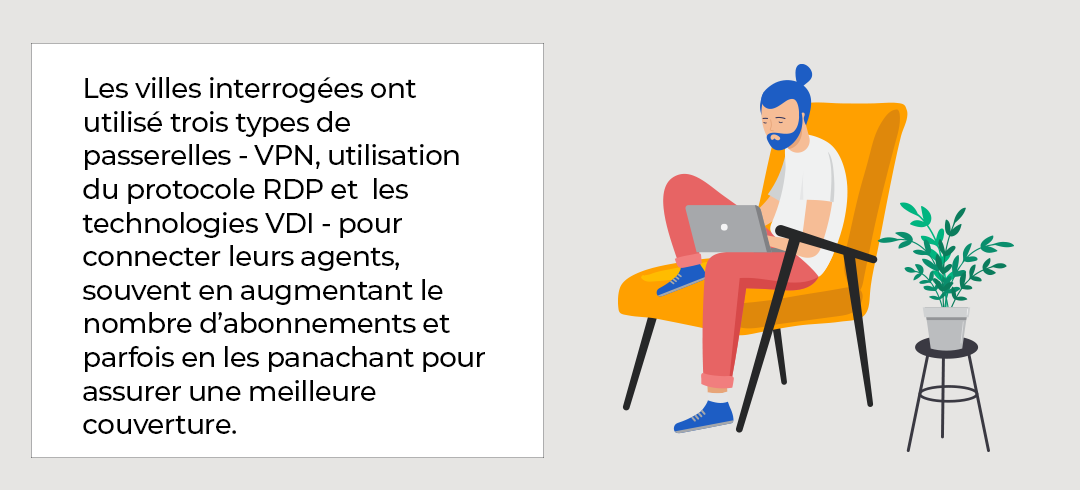Teleworking: An essential element of the business continuity plan for local authorities?

Often taken by surprise, they discovered a facet of teleworking they had never imagined, its logistical and technical complexities - due to a lack of sufficient equipment and resources - and its managerial and methodological constraints.
If the cities surveyed (Rosny sous Bois, Alfortville, Châlons-en-Champagne, Nancy) were rather successful in their examination of the transition to large-scale teleworking, it is mainly because they had a strong IT department and had already experimented with teleworking.
But all faced the same dual challenge: setting up a near-industrial teleworking infrastructure for as many employees as possible, and then supporting these employees in adopting new tools and innovative practices to enable them to continue their work.
How can we quickly connect employees to their work environment without compromising security?

- Connect as many teleworking employees as possible, primarily those included in the local authority's continuity plan,
- Enable employees to access their usual work environment from home: business tools, financial management, human resources management, and procedure management,
- Offer a quality service, in other words, sufficient bandwidth to enable everyone to work within the usual standards,
- Ensure optimal security conditions in order to preserve the community's digital heritage, a point that has become extremely sensitive with the upsurge in cyberattacks in recent weeks.
What infrastructure and connections are needed to make teleworking possible?

VPN (Virtual Private Network)
This is undoubtedly the most common type of network for accessing the community's business applications via the intranet (Châlons-en-Champagne, Nancy, Alfortville). While theoretically possible, the use of personal computers was not considered by any of the IT departments interviewed. For security reasons, all provided employees with municipally owned laptops, configured and equipped with antivirus software.
This constraint, however, automatically limited the number of users to the available machines and, in some cases, even required large quantities of laptops to be ordered. According to users, the subscription price for professional VPN access remains modest; however, the administration and maintenance costs are quite high.
RDP (Remote Desktop Protocol)
This is an application that allows employees to control their workstation from home, provided it remains switched on at all times (Alfortville Town Hall, Nancy Town Hall). This allows them to access all of their applications.
This type of solution also requires the use of a service provider. While more robust in terms of security, it remains complex to configure. Furthermore, the risk of disruptions in the local authority's validation procedures or difficulties accessing certain applications increases with the number of local government employees being shut down. This is why many local authorities are combining VPN access with RDP access to access different software packages.
VDI (Virtual Desktop Infrastructure) Systems
This IT virtualization technique, which allows users to access a virtual PC on a remote server via the cloud, is still relatively under-deployed in local authorities. However, it offers excellent flexibility, is designed to be accessible anywhere and on any device, and provides a high level of security since the data is stored in the data center and not on the client workstation. During this Covid-19 period, VDIs seem to fully justify their use, despite their relatively high cost. Local authorities that have made this transition, such as Rosny-sous-Bois, have been able to face the transition to remote working with relative peace of mind. In the case of Rosny, the switch to remote working for 200 employees took a few hours on the server and a few dozen hours on the user side for setup. Most employees work on their personal computers, and network administration is relatively resource-efficient. Many local authorities express interest in these technologies, which nevertheless require extensive digital transformation. Rosny, for example, has chosen to move its information system to a data center (two to be exact for security reasons), to the point that there is no longer a computer room at the town hall.
These three connection methods, VPN, RDP and VDI, have allowed thousands of agents to work without having to leave their homes. Moreover, it should be noted that to mitigate the brutal effects of the lockdown, Cedric O, the Secretary of State for Digital Affairs, launched an appeal to tech players to grant businesses, including local authorities, easy access to their teleworking solutions. This message has been heard since around forty operators and publishers are offering free and widespread access for the duration of the state of health emergency.
While cities were ultimately able to keep their users connected, the situation for smaller municipalities was more challenging. Many found themselves at a loss, lacking a VPN to access applications, sufficient laptops for remote working, and the skills to make the necessary changes. Service providers who could have stepped in were often unavailable due to the sharp increase in demand. Some municipalities had to rely on collaborative messaging to stay in touch with their employees, while others, more fortunate, benefited from the facilities offered by their software vendors. For example, Berger Levrault offered its clients remote access to enable remote working in secure conditions.
Finally, some good ideas emerged, such as repatriating work files to a cloud space to allow employees to remain productive at home, without being directly connected to the local authority's information system.
Access to work environments: good performance and also some shortcomings
Overall, remote workers were able to access most of their tools. However, the proposed infrastructure does not systematically provide access to everything (with the exception of VDI technologies). Indeed, most information systems were not initially designed for remote working. Over time, users and some departments have discovered malfunctions, broken processing chains, and sometimes dead ends:
- Applications not accessible from the VPN, even though financial officers, for example, need to access unlisted business applications.
- Breakdowns in validation chains related to employees not at their posts (illness, childcare) or to procedures requiring "rematerialization" at some point in the process.
- Lack of RGS signature cards to sign mandates and contracts.
- Decision-making functions not yet dematerialized: these concern, for example, the provision of electronic voting solutions for holding remote deliberative assemblies. These assemblies are temporarily authorized to meet via video conference; they may deliberate, provided, in particular, that the vote is public. However, this option remains subject to the state of health emergency (see box).
These examples confirm the distance still to be covered to implement measures covering all activities. This will undoubtedly be a project to be undertaken in the coming months, in the form of further modernizations of the information system, to enable local authorities to remain fully operational, even in the event of a partial or total lockdown.
Offering remote workers collaborative tools and innovating in terms of organization and methods

These collaborative toolboxes for remote workers make it possible to virtually reconstitute teams and, thanks to guest access, to continue work with external partners.
The market is brimming with cloud-based offerings, making them accessible anywhere and on any device. But, unsurprisingly, the most frequently cited products are American, such as Microsoft Teams or Slack. Those promoted by the government that are "more secure," such as Tchap (secure instant messaging), Webconference (video conferencing), or Osmose (community management), still seem to be reserved for central government, pending possible expansion.
The exception is local authorities that have opted for open source software. To address the most pressing issues, Nancy used the "means at hand" by creating a private extranet-style channel on her citizen participation platform [1], with several hundred access points. The platform's collaborative features are basic (proposals, questionnaires, debates), but, according to those responsible, remain suitable for communication and exchanges with officials. It should be noted that civic tech solution vendors also offer their platforms free of charge to promote such uses.
A few complementary, sometimes even redundant, tools are emerging, such as Zoom for video conferencing. The solution's ease of use and its ability to accommodate a large number of participants (several dozen, even hundreds) appealed to most of the cities surveyed, despite criticisms of the security and confidentiality risks the solution poses (partially corrected recently). Alfortville regularly convenes its crisis unit and recently held its first office meeting in this format. Nancy also uses it for external purposes, for example, to bring together local economic stakeholders and directors of cultural and socio-cultural establishments.
The gradual consolidation of the remote work organization has revealed new needs, particularly the need to plan projects to ensure their follow-up and reporting on completed services. Solutions such as Planner (Rosny, Châlons-en-Champagne) or Trello are also emerging for the coordination and monitoring of actions and projects.
In a slightly different vein, virtual switchboards have made a breakthrough because they offer more flexible solutions than traditional switchboards for mobilizing remote workers to receive their services. These cloud-based platforms allow for some of the workload from telephone reception centers to be shifted to town halls. They are frequently used to relieve congestion in solidarity services (complaints, health centers, dispensaries, CCAS reception, meal delivery, daycare registration for healthcare workers, mask distribution, registration of vulnerable people) and are relatively easy to implement (Rosny sous Bois, Alfortville, Châlons en Champagne).
How can we consolidate telework management and steering models?

However, the process remains sensitive, given the varying maturity of departments and certain divergences, as one director summarizes: "Telework highlights the pros and cons of the organization of our various departments. Some managers are having difficulty adapting to collaborative work. And consensus on work organization, the pace and mode of meetings, and controls often remains to be established." There is still a form of mistrust toward remote working, which could justify the implementation of cumbersome and restrictive control mechanisms.
This cultural disparity encourages management to adopt a cautious and progressive approach, best summed up by these three terms: "Learn, adapt, and improve." A few trends seem to be emerging in this spirit:
- The choice of decentralized organizations, in which managers play a central role by ensuring ongoing contact, coordination, support, and work distribution, seems to be gaining ground. Directions, guidance, and directives are more likely to be provided through the director-manager relationship.
- The desire to regularly communicate on progress and the launch of new initiatives, organizational choices, and best practices aims to provide visibility to employees. Communication also aims to strengthen relationships of trust, break down departmental silos, and mobilize collective intelligence. Examples of weekly or even daily information sheets and the organization of daily virtual meetings "around the coffee machine" to encourage informal exchanges (Nancy) seem to be increasing for this purpose.
- The search for a consensus on the human resources aspect of organizing teleworking from home and the rights and responsibilities of teleworkers has begun to update the special status.
Trials and errors remain, as to how to empower employees, avoid demobilization, lay the foundations for a trust contract with employees, and also regarding the post-COVID era, which is likely to see a further increase in the number of remote workers. But, in this period of reorganization and revision of certain firmly established principles, the mobilization of management to streamline labor relations is a harbinger of deeper and lasting changes.
From self-training to mastering tools and practices

Since the end of in-person learning, online training has become the preferred medium, designed to address teleworking from all angles: mastering tools (collaborative platform, specific tools), security (also adopting barrier gestures to avoid cyberattacks), mastering practices (how to host a video conference); organizing teleworking from home; and learning collaboration as a structuring element capable of connecting all the others.
On the operational level, for example, Rosny provides its employees with an integrated training system (Mandarine) to enable users to take full advantage of their collaborative suite and their new exchange and sharing capabilities. It includes usage- and product-oriented courses for communicating, collaborating, searching, and sharing information; short web conferences (30 minutes), led by a trainer; video tutorials; and a community social network. The advantage of this approach is that it offers both a comprehensive training program, with mandatory sections, and more flexible self-training materials to empower users and provide them with the means to improve their skills.
The three lessons from this first mandatory teleworking exercise
Real changes are to be expected. According to the estimates of most of the cities surveyed, teleworking will become a standard feature of the landscape due to force majeure. Through a domino effect, it will stimulate digitalization initiatives and perhaps also prompt the development of innovative projects to bring struggling communities into the transformation, regardless of their size, capabilities, and resources.
Teleworking will become a permanent fixture in local government administrations
Phase after phase of partial or even complete lockdown is likely to continue until a vaccine is available, and even beyond, in the event of a mutation of the current vaccine or the emergence of new viruses.
This constraint risks permanently entrenching the changes already experienced over the past few weeks: the reduction or even elimination of physical meetings (internally and with partners), lower office occupancy, the gradual spread of online training, and the development of remote collaborative working methods with partners, consultants, and suppliers.
Consequently, maintaining service activity at cruising speed, more extensive than the current degraded mode, will require an increase in remote working capacities and, consequently, the implementation of more robust, better prepared, and, above all, more extensive continuity plans in the event of a resumption of lockdown.
For reasons of resources and support for all public stakeholders, this preparation will be gradual and will focus on a few main methodological areas:
At the municipal and inter-municipal levels
-
- In-depth review of the functions, procedures, and services likely to be fully digitized, in order to prioritize and establish a roadmap accordingly.
- Evaluation of the necessary hardware purchases, particularly laptop purchases, which some expect to become widespread over the next three years.
- Identification and regular updating of the list of employees likely to switch to "telework" mode, as well as their functions and access needs.
- Conducting crash tests to assess the robustness of "Teleworking continuity plans" to address the risk of an epidemic. We will ensure the smooth running of procedures, the decompartmentalization of business applications where possible, and the planning of on-call duty to compensate for absences due to illness, childcare, or vacation.
At the departmental and even regional level
-
- Seek solutions that rely on EPCIs (public institutions for inter-municipal cooperation), departmental and regional councils to support smaller communities in this transformation,
- Scan or encourage the emergence of industrial solutions likely to limit the risk of cyberattacks, in order to avoid the accidents that have increased significantly in recent weeks (Marseille, Hauts-de-France, Charleville-Mézières, etc.)
- Ensure the availability of very high-speed broadband at the community level, as well as for employees working remotely from home, which will raise the question of accelerating FTTH deployment and coverage in rural areas.
- Assessment of the capacity to switch to remote working using digital technology educational activities and telehealth activities that are not mentioned in this notice, although they are also highly strategic.
The digitalization of administration could become one of the priorities of the next term
No teleworking without the dematerialization of a community's main functions and services. The digital transformation of systems will also become a key element in ensuring the continuity of services during lockdown phases.
Despite undeniable progress, many functions still need to be digitized.
- Teleservices, still expected to be fully deployed by 2022
- Decision-making procedures with the implementation of signature circuits (mandates, contracts) equipped with three-star RGS-type signature tools;
- The operation of assemblies, including the implementation of elected representatives' portals
- The deployment of supervision and hypervision tools to remotely monitor the proper functioning of utility services and urban networks
- The strengthening of distance education systems, particularly digital work environments for schools.
Similar to the choices made by Rosny-sous-Bois, some local authorities are tempted to migrate to the cloud for optimization reasons - to reduce the administrative burden, security, and Infrastructure and information systems maintenance and quality improvement priorities should prioritize the management and engineering of digital projects. They will expect greater reliability and flexibility from this.
The transformation will be profound and will require appropriate change management. It will mobilize expertise that is still relatively scarce and will generate new expenses at a time when it will be necessary to contain them. We can expect these expenses to be prioritized, within a framework of inter-territorial cooperation to achieve economies of scale and accelerate deployment.
Contrary to appearances, which generally point to the risks of loss of control and confiscation, these two models—transition to the cloud and pooling—could become the future pillars of regained sovereignty by enabling communities, even the smallest, to equip themselves with extensive digital services and share high-quality digital resources.
Sharing platforms and digital transformation projects appears to be a promising avenue for accelerating
COVID-19 has revealed both the robustness of information systems in some areas and the weaknesses and fragility of others. The communities that have shown the most resilience in the face of the crisis have a fairly homogeneous profile, which is a priori more difficult to achieve for small and medium-sized municipalities:
- A relatively robust IT department or community support through external resources in infrastructure, services, and project engineering,
- Teleworking practices predating the Covid-19 epidemic
- Information system modernization has begun, or even better, is well advanced.
- An up-to-date digital culture and a vision of the new paths to follow.
In recent weeks, the accumulation of difficulties in effectively responding to lockdown constraints has led municipalities to turn to their EPCI (public inter-municipal cooperation bodies) for assistance, even more frequently than usual, to explore the conditions for pooling their IT resources at the inter-municipal level. We can hope that this acceleration in the need for cooperation will be sustainable. In any case, it allows us to consider with greater confidence a prospect that, until the Covid-19 period, remained difficult.
To help less-equipped communities and, in particular, reduce the inequalities in online services that affect them and their fellow citizens, pooling resources could offer new perspectives, requiring a twofold precaution:
- Provide educational insight by demonstrating the positive impact on public spending and externalities generated by cooperation and resource pooling
- Highlight the gains in sovereignty that could be achieved by communities involved in such cooperation projects
EPCIs and departmental councils are beginning to formulate new working hypotheses such as:
- The shift of small communities' IT to the cloud with complete virtualization of their information systems. This would, however, require the provision of very high-speed, high-quality bandwidth.
- The creation of shared application catalogs, prioritizing existing solutions to complement the internal toolbox and expand the range of remote services.
- The establishment of IT project engineering units, tasked with supporting local authorities—with the support of private firms—in updating their digital strategy and in developing and supporting projects.
- The creation of stakeholder communities at the level of the involved territory(ies) to share best practices and create a climate of exchange, mutual support, and trust.
These initiatives, already underway in a few territories, could expand with the broader involvement of departments and the commitment of regional councils, and even the State. With assistance to encourage groupings, the Departments would have genuine legitimacy to play the role of emulators and guarantors of respect for balances in the new institutional arrangements. Their expertise in the area of solidarity allows them to intervene across a broad spectrum, as part of their support to municipalities. Cooperation and pooling in digital technology represent the promise of accelerating the digital transition in all areas, regardless of their size or resources.
Like many observers, who loudly assert that "nothing will ever be the same again," local government management also seem convinced that a post-Covid-19 era will bring decisive digital transformations, particularly regarding remote working. Assessments and evaluations will first need to be conducted to understand the scope of the phenomenon, gauge expectations, and define priorities. But prompt action will be needed to capitalize on the wave and prevent the new enthusiasm from waning. Continuing to reflect on the right strategies and preparing and then initiating, in parallel, priority digital projects should now be on everyone's minds as soon as the lockdown is partially lifted if we want to be ready and emerge from this crisis, which is both dangerous and promising.
[1] Nancy uses the open-source participatory democracy platform, Decidim.

Philippe
Focus on holding deliberative assemblies by audio or video conference
The ordinance aimed at ensuring the continued operation of local institutions (Ordinance 2020-391 of April 1, 2020) provides for specific provisions regarding teleconferencing, transmission, and electronic publication of proceedings during the state of health emergency.
These provisions allow the mayor or president to decide that a meeting of a municipal or community council, or any other deliberative body, may be held by video conference or, failing that, by audio conference.
Meetings are public, with this obligation being met when the debates are accessible live to all, electronically. Votes may only be held by public ballot (either by roll call or electronic ballot). On the other hand, if a request for a secret vote is adopted, the session cannot be held electronically, which would then constitute a sticking point.
